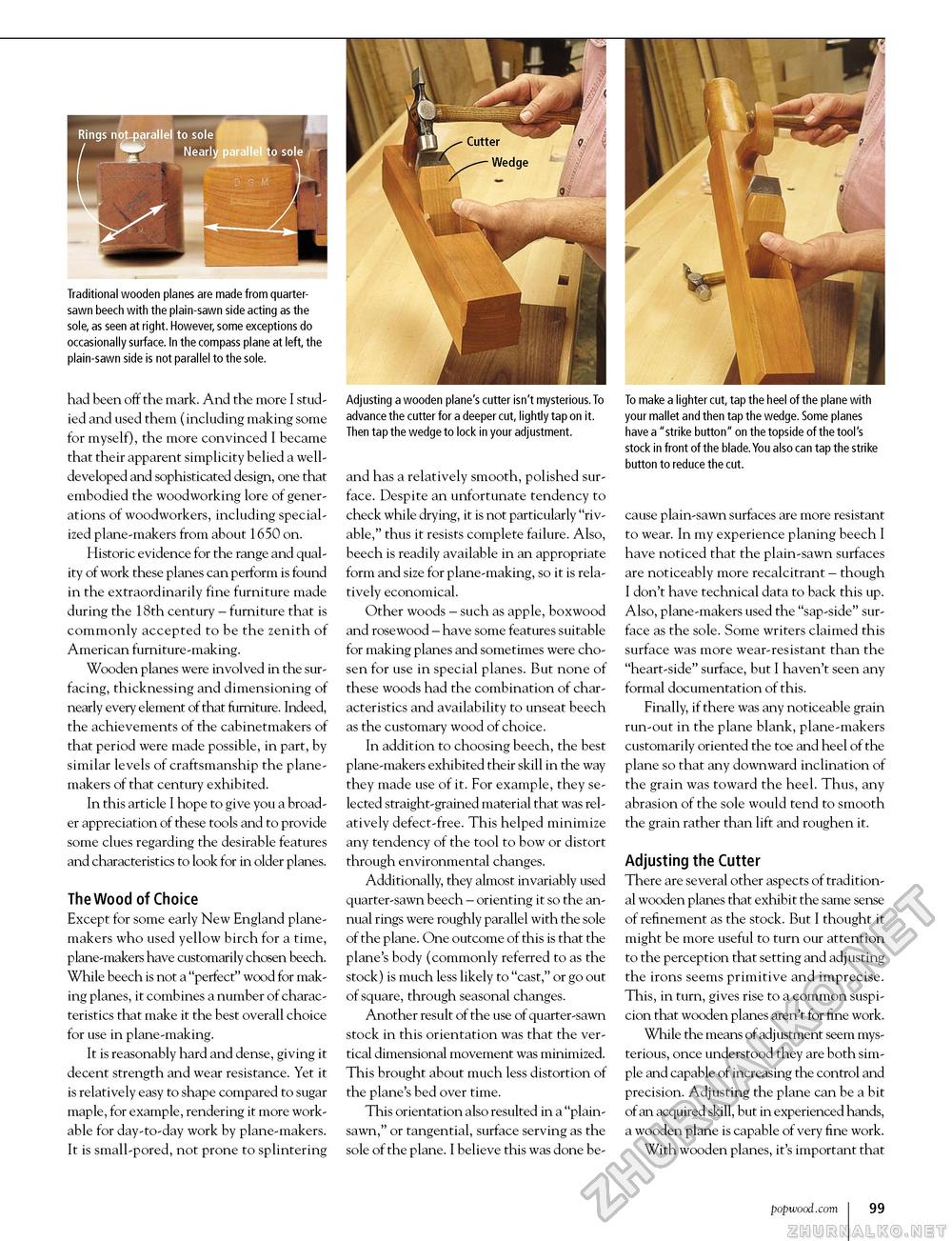Popular Woodworking 2003-12 № 138, страница 98
■■■ < Traditional wooden planes are made from quarter-sawn beech with the plain-sawn side acting as the sole, as seen at right. However, some exceptions do occasionally surface. In the compass plane at left, the plain-sawn side is not parallel to the sole. f > I Cutter ■ Wedge 1 had been off the mark. And the more I studied and used them (including making some for myself), the more convinced I became that their apparent simplicity belied a well-developed and sophisticated design, one that embodied the woodworking lore of generations of woodworkers, including specialized plane-makers from about 1650 on. Historic evidence for the range and quality of work these planes can perform is found in the extraordinarily fine furniture made during the 18th century - furniture that is commonly accepted to be the zenith of American furniture-making. Wooden planes were involved in the surfacing, thicknessing and dimensioning of nearly every element of that furniture. Indeed, the achievements of the cabinetmakers of that period were made possible, in part, by similar levels of craftsmanship the plane-makers of that century exhibited. In this article I hope to give you a broader appreciation of these tools and to provide some clues regarding the desirable features and characteristics to look for in older planes. The Wood of Choice Except for some early New England plane-makers who used yellow birch for a time, plane-makers have customarily chosen beech. While beech is not a "perfect" wood for making planes, it combines a number of characteristics that make it the best overall choice for use in plane-making. It is reasonably hard and dense, giving it decent strength and wear resistance. Yet it is relatively easy to shape compared to sugar maple, for example, rendering it more workable for day-to-day work by plane-makers. It is small-pored, not prone to splintering Adjusting a wooden plane's cutter isn't mysterious. To advance the cutter for a deeper cut, lightly tap on it. Then tap the wedge to lock in your adjustment. and has a relatively smooth, polished surface. Despite an unfortunate tendency to check while drying, it is not particularly "riv-able," thus it resists complete failure. Also, beech is readily available in an appropriate form and size for plane-making, so it is relatively economical. Other woods - such as apple, boxwood and rosewood - have some features suitable for making planes and sometimes were chosen for use in special planes. But none of these woods had the combination of characteristics and availability to unseat beech as the customary wood of choice. In addition to choosing beech, the best plane-makers exhibited their skill in the way they made use of it. For example, they selected straight-grained material that was relatively defect-free. This helped minimize any tendency of the tool to bow or distort through environmental changes. Additionally, they almost invariably used quarter-sawn beech - orienting it so the annual rings were roughly parallel with the sole of the plane. One outcome of this is that the plane's body (commonly referred to as the stock) is much less likely to "cast," or go out of square, through seasonal changes. Another result of the use of quarter-sawn stock in this orientation was that the vertical dimensional movement was minimized. This brought about much less distortion of the plane's bed over time. This orientation also resulted in a "plain-sawn," or tangential, surface serving as the sole of the plane. I believe this was done be- To make a lighter cut, tap the heel of the plane with your mallet and then tap the wedge. Some planes have a "strike button" on the topside of the tool's stock in front of the blade.You also can tap the strike button to reduce the cut. cause plain-sawn surfaces are more resistant to wear. In my experience planing beech I have noticed that the plain-sawn surfaces are noticeably more recalcitrant - though I don't have technical data to back this up. Also, plane-makers used the "sap-side" surface as the sole. Some writers claimed this surface was more wear-resistant than the "heart-side" surface, but I haven't seen any formal documentation of this. Finally, if there was any noticeable grain run-out in the plane blank, plane-makers customarily oriented the toe and heel of the plane so that any downward inclination of the grain was toward the heel. Thus, any abrasion of the sole would tend to smooth the grain rather than lift and roughen it. Adjusting the Cutter There are several other aspects of traditional wooden planes that exhibit the same sense of refinement as the stock. But I thought it might be more useful to turn our attention to the perception that setting and adjusting the irons seems primitive and imprecise. This, in turn, gives rise to a common suspicion that wooden planes aren't for fine work. While the means of adjustment seem mysterious, once understood they are both simple and capable of increasing the control and precision. Adjusting the plane can be a bit of an acquired skill, but in experienced hands, a wooden plane is capable of very fine work. With wooden planes, it's important that popwood.com 109 |








